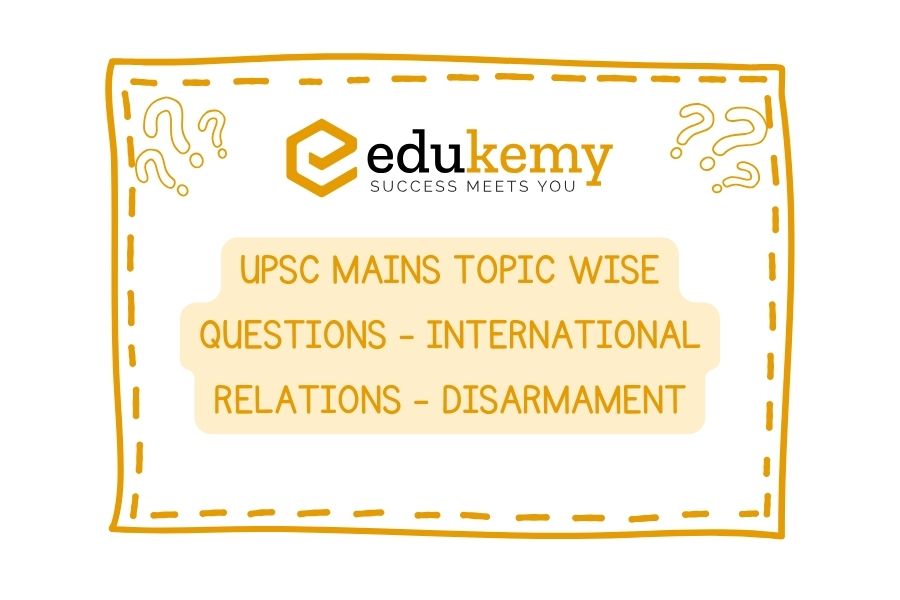Discover a curated selection of UPSC Mains Topic Wise Questions focused on International Relations, specifically exploring Disarmament. Dive into a diverse array of questions meticulously crafted to deepen your understanding and preparation for the UPSC Main examination. This resource provides a structured approach to mastering key concepts essential for comprehending and addressing disarmament issues on a global scale. Whether you’re a novice seeking foundational knowledge or an advanced candidate refining your understanding, these questions offer valuable insights and practice opportunities. With a strategic emphasis on topic-wise questions, aspirants can enhance analytical skills and develop a comprehensive understanding of disarmament dynamics. Elevate your preparation, grasp essential insights, and optimize your performance in the UPSC Mains with proficiency in disarmament within the realm of International Relations.
Contents
- 1 Q1. What is meant by SDI? (2000, 2 Marks)
- 2 Q2. Differentiate between SALT and START. (2000, 2 Marks)
- 3 Q3. Highlight the main points of Nuclear Disarmament Treaty signed by U.S. President George Bush and Russian President Vladimir Putin in May 2002. (2002, 15 Marks)
- 4 Q4. Comment on the present status of the Biological Weapons Convention (BWC). What important issues, do you think, need to be taken up at the seventh review conference of the BWC scheduled for 2011? (2010, 12 marks)
- 5 In case you still have your doubts, contact us on 9811333901.
Q1. What is meant by SDI? (2000, 2 Marks)
Answer: SDI stands for Serial Digital Interface. It’s a standard for transmitting uncompressed digital video and audio signals over coaxial or fiber optic cables. Used in professional broadcast applications, SDI ensures high-quality, reliable transmission between video cameras, routers, and displays.
Q2. Differentiate between SALT and START. (2000, 2 Marks)
Answer: SALT (Strategic Arms Limitation Talks) and START (Strategic Arms Reduction Treaty) addressed nuclear arms control. SALT (1972) focused on limiting offensive launchers, while START (1991) aimed for deeper reductions and destruction of delivery vehicles.
Q3. Highlight the main points of Nuclear Disarmament Treaty signed by U.S. President George Bush and Russian President Vladimir Putin in May 2002. (2002, 15 Marks)
Answer: The Nuclear Disarmament Treaty signed in May 2002 by U.S. President George Bush and Russian President Vladimir Putin, known as the Strategic Offensive Reductions Treaty (SORT), marked a significant milestone in global efforts towards nuclear disarmament. The treaty aimed to reduce the nuclear arsenals of both countries and enhance international security through mutual cooperation and transparency. The main points of the treaty are as follows:
- Reduction of Strategic Nuclear Weapons: The treaty committed both the United States and Russia to reduce their strategic nuclear warheads to levels between 1,700 and 2,200 within a timeframe of ten years, by December 31, 2012.
- Bilateral Verification Measures: The treaty established a framework for transparent verification measures to ensure compliance with the agreed-upon reductions. This included regular exchanges of data and information related to nuclear arsenals and facilities, as well as on-site inspections.
- Flexibility in Implementation: SORT provided flexibility in the implementation of reductions, allowing both parties to decide the composition and structure of their respective nuclear forces while meeting the agreed-upon limits.
- Non-binding Nature: Unlike traditional arms control treaties, SORT did not include specific verification protocols or measures for enforcement. However, it relied on the existing verification mechanisms and mutual trust between the two nations.
- Confidence-Building Measures: The treaty aimed to enhance confidence-building measures between the United States and Russia, promoting stability and predictability in their strategic relationship.
Overall, the Nuclear Disarmament Treaty signed by Presidents Bush and Putin in 2002 represented a significant step towards nuclear arms reduction, fostering a more secure international environment and paving the way for future disarmament efforts.
Q4. Comment on the present status of the Biological Weapons Convention (BWC). What important issues, do you think, need to be taken up at the seventh review conference of the BWC scheduled for 2011? (2010, 12 marks)
Answer: The Biological Weapons Convention (BWC) is a cornerstone of global disarmament, prohibiting the development, production, and stockpiling of biological and toxin weapons. Despite near-universal membership, the BWC faces challenges:
Present Status:
- Strengths: The BWC enjoys broad adherence and has fostered a strong norm against biological weapons.
- Weaknesses: The BWC lacks a robust verification regime, making it difficult to ensure compliance. Additionally, advancements in biotechnology raise concerns about dual-use research, where legitimate scientific pursuits could be misused for weaponization.
Key Issues for the 7th Review Conference (2011):
- Strengthening Verification: Explore mechanisms for increased transparency and on-site inspections to deter potential violations.
- Addressing Dual-Use Research: Establish international guidelines to ensure research serves peaceful purposes and minimize the risk of misuse.
- Promoting Universalization: Encourage remaining states to join the BWC to achieve comprehensive global coverage.
- Enhancing Biosecurity: Promote international cooperation to strengthen national biosecurity measures and prevent accidental or deliberate releases.
A successful 7th Review Conference should address these issues to ensure the continued effectiveness of the BWC in a rapidly evolving biological science landscape.
In case you still have your doubts, contact us on 9811333901.
For UPSC Prelims Resources, Click here
For Daily Updates and Study Material:
Join our Telegram Channel – Edukemy for IAS
- 1. Learn through Videos – here
- 2. Be Exam Ready by Practicing Daily MCQs – here
- 3. Daily Newsletter – Get all your Current Affairs Covered – here
- 4. Mains Answer Writing Practice – here


